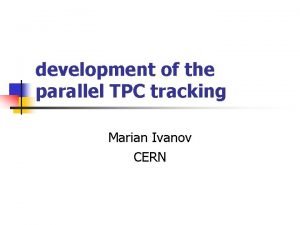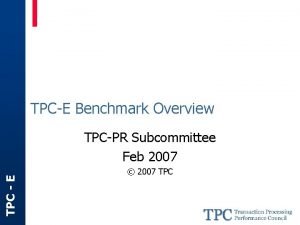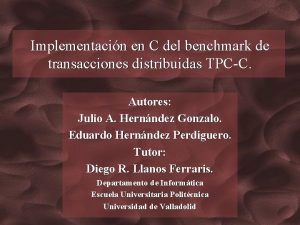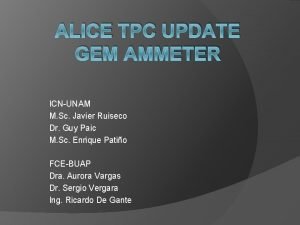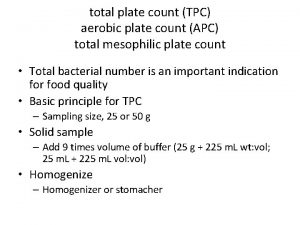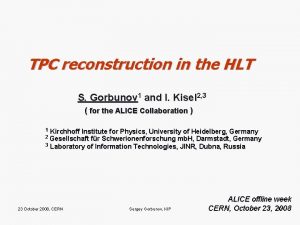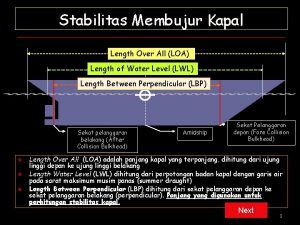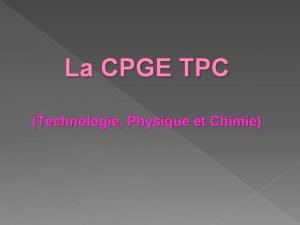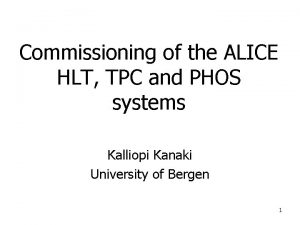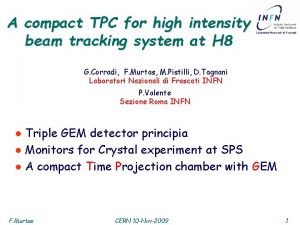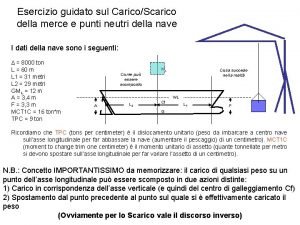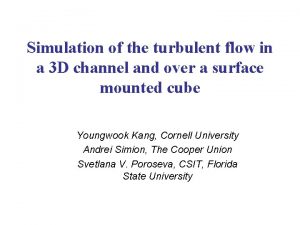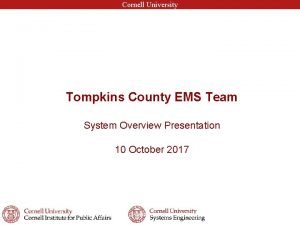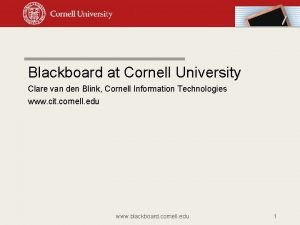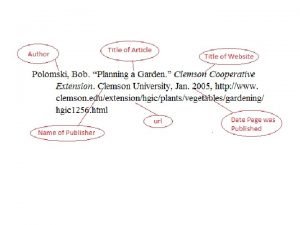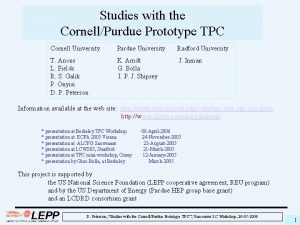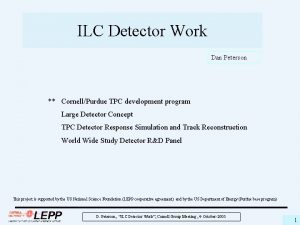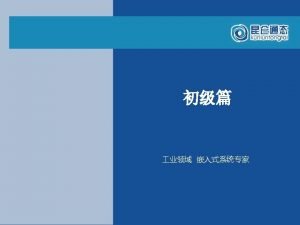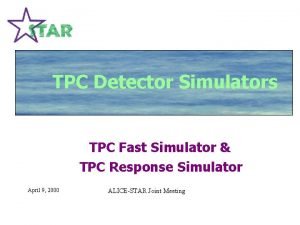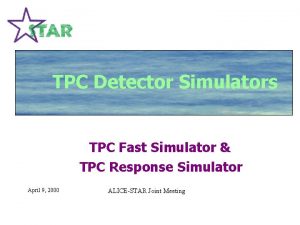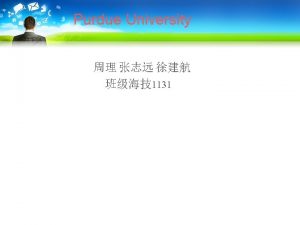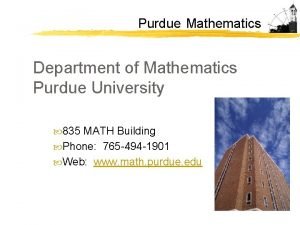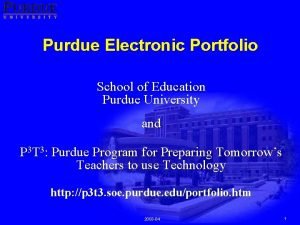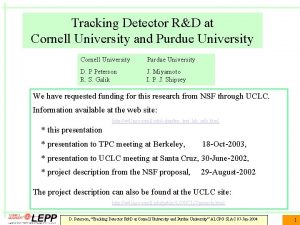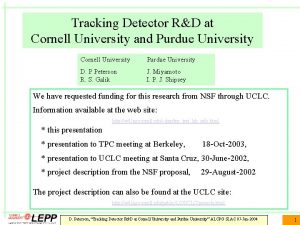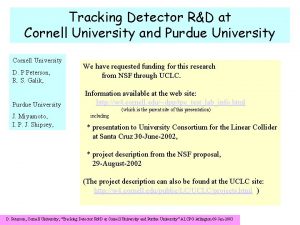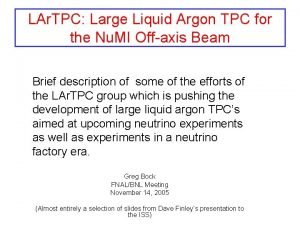The CornellPurdue TPC Cornell University Purdue University D


















- Slides: 18

The Cornell/Purdue TPC Cornell University Purdue University D. P. Peterson L. Fields R. S. Galik P. Onyisi G. Bolla I. P. J. Shipsey * this presentation: ECFA 2005 Vienna * presentation at ALCPG Snowmass * presentation at LCWS 05, Stanford * presentation at TPC mini-workshop, Orsay 24 -November-2005 23 -August-2005 21 -March-2005 12 -January-2005 Information available at the web site: http: //w 4. lns. cornell. edu/~dpp/tpc_test_lab_info. html This project is supported by the US National Science Foundation (LEPP cooperative agreement) and by the US Department of Energy (HEP group base grant) and an LCRD/UCLC consortium grant D. Peterson, “The Cornell/Purdue TPC” , ECFA , Vienna , 15 -November-2005 1

TPC The construction is influenced by our research goal: to compare the various amplification technologies in a common environment. 14. 6 cm ID field cage - accommodates a 10 cm GEM 64 cm drift field length 22. 2 cm OD outer structure (8. 75 inch) “field cage termination” and “final” return lines for the field cage HV distribution allow trimming the termination bias voltage. Read-out end: field cage termination readout pad and amplification module pad biasing boards CLEO II cathode preamps D. Peterson, “The Cornell/Purdue TPC” , ECFA , Vienna , 15 -November-2005 2

Field cage termination The instrumented readout area is ~2 cm x 7 cm , 32 pads. 10 cm Field cage termination area is 10 cm square The biased area is 10 cm square. ( This pad board allows ~3 x 9 cm , 62 pads. ) D. Peterson, “The Cornell/Purdue TPC” , ECFA , Vienna , 15 -November-2005 3

MPWC and GEM amplification 10 cm Shown: single-GEM Will discuss Single-GEM and double-GEM. The readout module including the amplification device mounted on pad board The instrumented readout area is ~2 cm x 7 cm , 32 pads. The biased area is 10 cm square. (This pad board allows ~3 x 9 cm , 62 pads. ) D. Peterson, “The Cornell/Purdue TPC” , ECFA , Vienna , 15 -November-2005 4

Electronics High voltage system: -20 k. V module, 2 channels available -2 k. V module, 4 channels available (not part of interfaced system) +2 k. V Readout: VME crate PC interface card Lab. View Struck FADC 32 channels (room for expansion) 105 M Hz 14 bit +/- 200 m. V input range ( least count is 0. 025 m. V ) NIM external trigger input circular memory buffer D. Peterson, “The Cornell/Purdue TPC” , ECFA , Vienna , 15 -November-2005 5

MWPC gas-amplification MWPC built at Cornell with CLEO III drift chamber spare parts. mounted Dec-2004 biasing: field cage, -20 k. V, 300 V/cm termination: -900 V termination: grid 300 V/cm, 10 mm grid: -600 V grid: anode 5 mm anode: +550 V anode: pads 5 mm pads: -2000 V D. Peterson, “The Cornell/Purdue TPC” , ECFA , Vienna , 15 -November-2005 6

MWPC event (typical) Ar. CO 2 (10%) , 300 V/cm 25 MHz , 40 ns 2048 time buckets (81. 92 ms) D. Peterson, “The Cornell/Purdue TPC” , ECFA , Vienna , 15 -November-2005 7

single GEM CERN GEM mounted, tested by Purdue installed 11 -March-2005 biasing: field cage, -20 k. V, 300 V/cm termination: -900 V termination : GEM 960 V/cm , 0. 5 cm GEM voltage: -400 V , -400 V: 0 V (Gas amplification ~100. ) GEM : pads: 5000 V/cm , 0. 3 cm, pads: +1500 V D. Peterson, “The Cornell/Purdue TPC” , ECFA , Vienna , 15 -November-2005 8

single-GEM event Note the 1 mv scale. Gas amplification is about 100 Ar. CO 2 (10%) , 300 V/cm 25 MHz , 40 ns 2048 time buckets (81. 92 ms) D. Peterson, “The Cornell/Purdue TPC” , ECFA , Vienna , 15 -November-2005 9

single-GEM after smoothing & common noise subtraction Ar. CO 2 (10%) , 300 V/cm 25 MHz , 40 ns 2048 time buckets (81. 92 ms) D. Peterson, “The Cornell/Purdue TPC” , ECFA , Vienna , 15 -November-2005 10

double-GEM CERN GEM mounted, tested by Purdue installed 20 -October-2005 biasing: field cage, -20 k. V, 300 V/cm termination: -919 V termination : GEM 2 300 V/cm , 0. 432 cm GEM 2 voltage: -370 V , -789 V: -419 V GEM 2: GEM 1 300 V/cm , . 165 cm GEM 1 voltage: -370 V , -370 V: 0 GEM 1: pads 5000 V/cm , . 165 cm pads: +825 V D. Peterson, “The Cornell/Purdue TPC” , ECFA , Vienna , 15 -November-2005 11

double-GEM event Ar. CO 2 (10%) , 300 V/cm drift velocity = 22 mm/ns drift distance ~55 cm 25 MHz , 40 ns 2048 time buckets (81. 92 ms) D. Peterson, “The Cornell/Purdue TPC” , ECFA , Vienna , 15 -November-2005 12

charge width The charge width for the 1 -GEM (shown at Snowmass) was influenced by the common “noise” subtraction. The 2 -GEM does not require common “noise” subtraction. D. Peterson, “The Cornell/Purdue TPC” , ECFA , Vienna , 15 -November-2005 13

hit resolution (5 mm pad) find tracks - require time coincident signals MWPC: 6 layers, GEM: 5 layers find PH center using maximum PH pad plus nearest neighbors (total 2 or 3 pads) MWPC: select clean, “contained” hits require the hit PH sum to contain 70% of layer PH sum require 5 layers with interior hits ( Max. ph pad is NOT on the edge. ) fit to a line may eliminate 1 hit with residual > 2. 5 mm ( Still require 5 layers with interior hits. ) refit double-GEM: select 4 clean, charge-share hits require sum of 2 pads > 96% of layer pulse height require peak pad PH < 92% of layer require 4 hits, 1 each in layers (1, 2) (3, 4, 5) (6, 7) fit correct: s 2 = Sr 2/DOF ; s = RMS * (points/DOF)1/2 D. Peterson, “The Cornell/Purdue TPC” , ECFA , Vienna , 15 -November-2005 14

Future: Finer Segmentation Pad Board finally make resolution measurements with 2 mm pads We can purchase a minor increase the DAQ , 16 channels. 48 channels will allow … 2 rows of 2 mm pads plus 4 rows of 5 mm pads for track definition Or. . 1 row of 2 mm pads 4 rows of 5 mm pads 8 channels for positive ion feedback measurement D. Peterson, “The Cornell/Purdue TPC” , ECFA , Vienna , 15 -November-2005 15

Future: Ion Feedback Measurement Positive ions are created in the amplification and drift back into the field cage. We will attempt to measure the ion feedback on the field cage termination plane, for individual tracks. The method differs from that used by Saclay/Orsay on Micro. Megas and by Aachen on GEM. For those measurements, a source was used to create ionization. Current was measured on the cathode. D. Peterson, “The Cornell/Purdue TPC” , ECFA , Vienna , 15 -November-2005 16

Ion Feedback Measurement Require small ion drift time to reduce diffusion. (Expect ~7 ms diffusion at 540 ms drift. ) Require large ion drift time because the amplifiers saturate during the voltage ramp. New amplifiers will have time to recover with this drift time. D. Peterson, “The Cornell/Purdue TPC” , ECFA , Vienna , 15 -November-2005 17

Next 1 year Cornell/Purdue: Minor equipment expansion Purchase low noise, positive HV supply for the anode Implement rows of small pads. ( Large pads, similar to the present pads, will be used for track definition. ) Switch to TESLA TDR gas. Compare 2 -GEM, 3 -GEM, Micro. Megas, and Wires within the same TPC. Compare multiple assemblies of “identical” gas-amplification devices. Measure resolution vs. drift distance, details of biasing, gas, ( location on pad ). Measure ion feedback with the various gas-amplification devices. Purdue: next: mount a 3 M Micro. Megas on the old pad board Carleton: The Carleton group (Alain Bellerive and Madhu Dixit) will prepare gas-amplification devices on the Cornell readout board for mounting in the Cornell/Purdue TPC. This will include resistive charge dispersion read-out stages. The groups will share in data-taking and developing a common analysis. D. Peterson, “The Cornell/Purdue TPC” , ECFA , Vienna , 15 -November-2005 18
 Tpc kink
Tpc kink Tpcpr
Tpcpr Tpc-c benchmark
Tpc-c benchmark Tpc.msc
Tpc.msc How to calculate cfu/ml
How to calculate cfu/ml Tpc global tracking
Tpc global tracking What is fresh water allowance
What is fresh water allowance Kapal mauna loa
Kapal mauna loa Filiere tpc
Filiere tpc Ecs commissioning
Ecs commissioning Tpc traking
Tpc traking Punti neutri di una nave
Punti neutri di una nave Pasnet tpc
Pasnet tpc Cornell nbb
Cornell nbb Cornell university fluent laminar pipe flow
Cornell university fluent laminar pipe flow Ivy league executive education
Ivy league executive education Cornell university ems
Cornell university ems Cornell blackboard
Cornell blackboard Owl purdue university
Owl purdue university
